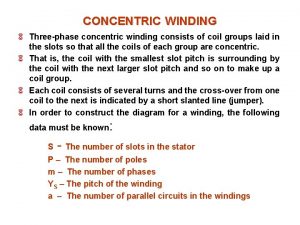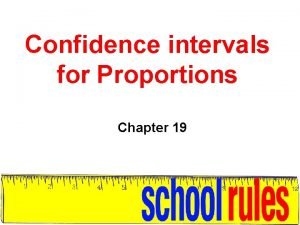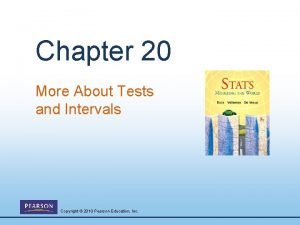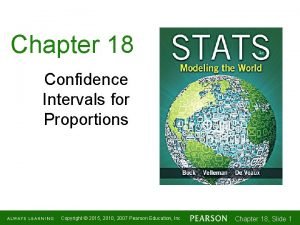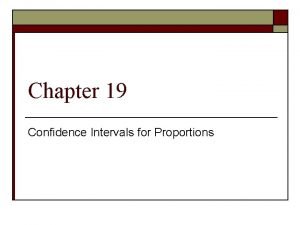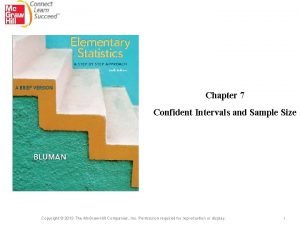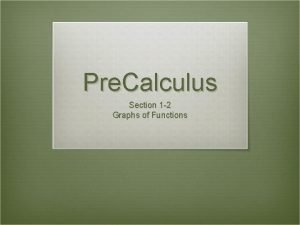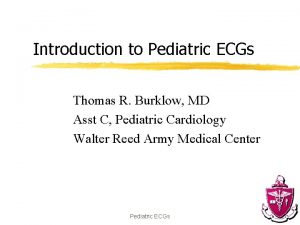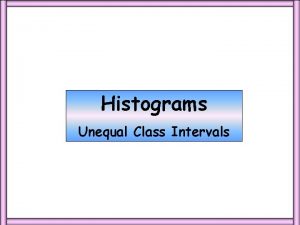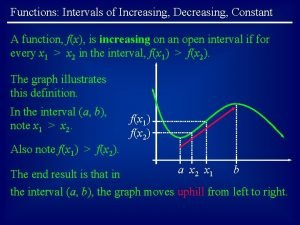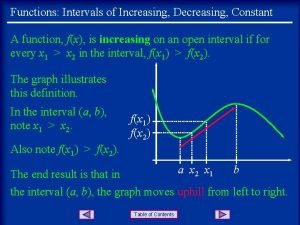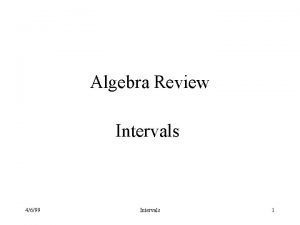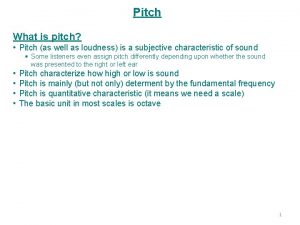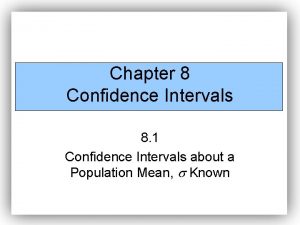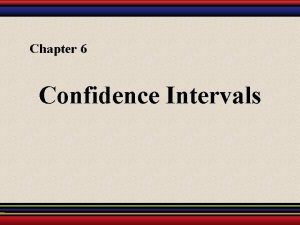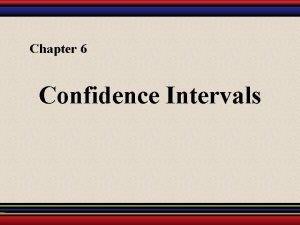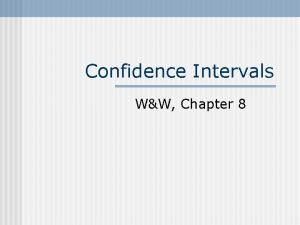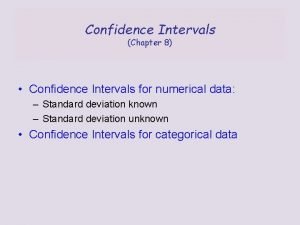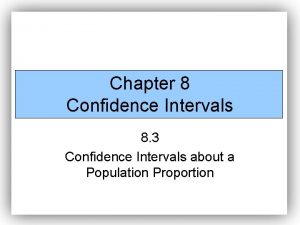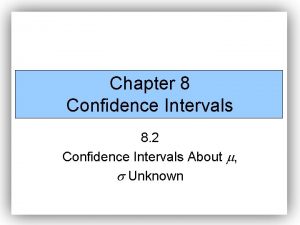PITCH INTERVALS CHAPTER 6 PITCH INTERVALS Key Concept


































- Slides: 34

PITCH INTERVALS CHAPTER 6

PITCH INTERVALS Key Concept – page 95 An interval measures the musical space between two pitches or pitch classes. The intervals between pitches are called pitch intervals. The intervals between pitch classes are called pitch-class intervals.

GENERIC INTERVALS • Labeled with a number, not a specific quality. • Numbers include: • • • 1 2 3 4 5 6 7 8 Etc.

LABELING GENERIC INTERVALS • Starting with the bottom pitch, count it as 1 • Count the lines and spaces to the next pitch • The number you count is the generic interval

LABELING GENERIC INTERVALS • You can also use scales for intervals • For example: • In the Key of C • • C-C = 1 (Unison – same pitches) C-D = 2 C-E = 3 C-F = 4 C-G = 5 C-A = 6 C-B = 7 C-C = 8

ASSIGNMENT – TRY IT #2 – PAGE 96 Name the generic interval spanned by each pair of pitches.

MELODIC VERSUS HARMONIC INTERVALS • A melodic interval is the distance between to successive pitches • A harmonic interval is the distance played simultaneously

SIMPLE GENERIC INTERVALS Intervals that span within an octave.

COMPOUND INTERVALS • A compound interval is an interval larger than one octave • When labeling compound intervals be careful to get correct intervals • Two options: • Count the distance between the pitches • Formula of: 7 + s (7 + the simple interval number) Example: C 4 – D 5 = (M)9 7+2=9 (This is because the unison is 1 and not 0. ) 8 9 10 11 12 13 14 15

INTERVAL QUALITY Key Concept – page 99 When two generic pitch intervals share the same interval number but are not the exact same size, the difference in size is called the interval quality.

TYPES OF INTERVAL QUALITY • • • Major (based on the major scale) Perfect (based on the major scale) Minor (half step smaller than major intervals) Diminished (half step smaller than perfect and minor intervals) Augmented (half step larger than major and perfect intervals) Key Concept – page 100 Major intervals are a half step larger than minor intervals.

TYPES OF INTERVAL QUALITY HANDOUT

EXAMPLES

USING MAJOR SCALES TO SPELL PITCH INTERVALS To get a major 3 rd above the scale tonic, think about the major scale. For example: Major third above G is B The same goes for minor scales.

USING MAJOR SCALES TO SPELL PITCH INTERVALS Key Concept – page 102 One quick way to spell a pitch interval is to imagine that the interval is in a key, where the bottom note is the tonic and the upper note lies somewhere in the scale. 1. Always begin by writing the generic interval first (by counting lines and spaces. ) 2. If the interval you want is perfect (unison, 4 th, 5 th, or octave) or major (2 nd, 3 rd, 6 th, or 7 th), add an accidental to the upper note so that it conforms to the major key signature of the bottom note. 3. If the interval you want is a minor 3 rd, 6 th, or 7 th, add an accidental to the upper note that conforms to the minor key signature of the bottom note. 4. If the interval you want is a minor second, follow step #1, then add an accidental to the upper note if needed to make the interval a half step.

USING MAJOR SCALES TO SPELL PITCH INTERVALS 1. Always begin by writing the generic interval first (by counting lines and spaces. )

USING MAJOR SCALES TO SPELL PITCH INTERVALS 2. If the interval you want is perfect (unison, 4 th, 5 th, or octave) or major (2 nd, 3 rd, 6 th, or 7 th), add an accidental to the upper note so that it conforms to the major key signature of the bottom note.

3. If the interval you want is a minor 3 rd, 6 th, or 7 th, add an accidental to the upper note that conforms to the minor key signature of the bottom note.

USING MAJOR SCALES TO SPELL PITCH INTERVALS 4. If the interval you want is a minor second, follow step #1, then add an accidental to the upper note if needed to make the interval a half step.

ASSIGNMENT – TRY IT #5 - PAGE 102 Name the following notes.

USING MAJOR SCALES TO IDENTIFY PITCH INTERVALS Think of the scale of the tonic to help identify an interval that has been spelled for you. For example: F is the top pitch. C is the bottom pitch. Identify the generic interval. Use scales to determine the quality.

ASSIGNMENT – TRY IT #6 - PAGE 103 Name the following intervals.

SPELLING PITCH INTERVALS BENEATH A GIVEN NOTE If we want to spell a major 6 th below C: 1. Write the generic interval by counting down 6. (This pitch is now the tonic. ) 2. Ask, “Does the C fit the E-Major scale? ” 3. What has to be done so the C fits a scale in which a form of E is the tonic? We can NOT change the given pitch. 4. Add an accidental to the E so we have a major 6 th.

ASSIGNMENT – TRY IT #7 ON PAGE 103 Name the following notes:

ANOTHER WAY TO SPELL PITCH INTERVALS 1. Label the generic interval. 2. Count the number of semitone (half-steps).

THE TRITONE A tritone is the interval between P 4 and P 5. (Tri stands for the 3 whole steps (6 half steps) of the interval. ) This interval may be spelled as an A 4 or a d 5. (If the generic interval is 4, it will be an A 4. If the generic interval is 5, it will be a P 5. ) A 4 d 5

SPELLING DIMINISHED AND AUGMENTED INTERVALS Key Concept - page 105 When a major or perfect interval is made one chromatic help step larger, we call it augmented. When a minor or perfect interval is made one chromatic half step smaller, we call it diminished. When a major or perfect interval is made one whole step larger (without changing the letter names of the pitches), we call it doubly augmented. When a minor or a perfect interval is made one whole step smaller (without changing the letter names of the pitches) we call it doubly diminished.

ENHARMONIC EQUIVALENT INTERVALS Enharmonic Equivalent Intervals are intervals that span the same number of semitones but have different interval names. For example a minor 3 rd from F to Ab and an augmented second from F to G# both span three semitones.

THE RELATIVE CONSONANCE AND DISSONANCE OF INTERVALS • Consonant intervals sound pleasing to the ear or are tonally stable. (Unison, 3 rd, 5 th, 6 th, and Octave - perfect/major and minor) • Dissonant intervals sound tonally active, there is a need to resolves, and unpleasant. (2 nd, (4 th, ) and 7 th - major and minor; any augmented or diminished intervals) • Perfect consonances are unisons, fifths, and octaves due to their pure acoustic properties. (Unison, 5 th, Octave) • Imperfect consonances are not considered to be acoustically pure. (3 rd and 6 th)

SUMMARY - PAGE 108 • Consonant intervals: unison, third, fifth, octave • Dissonant intervals: second, seventh, any augmented or diminished interval • Special case: fourth (acoustically consonant; melodic interval is usually a consonance, harmonic interval is usually a dissonance)

THE INVERSION OF INTERVALS • Inversionally related intervals are intervals that are spelled with the same pitches but in a different ordered.

THE INVERSION OF INTERVALS Key Concept - page 109 Things to keep in mind when determining the quality and size of an interval inversion. 1. Quality: • • • Perfect intervals remain perfect; Major intervals invert to minor, and vice versa; Diminished intervals invert to augmented, and vice versa 2. Size: • The two numbers always sum to 9; for example 1 inverts to 8, 3 inverts to 6, 4 inverts to 5, etc.

THE INVERSION OF INTERVALS

ASSIGNMENT - TRY IT #9 - PAGE 109 For each pair of pitches below, name the interval. Then write the inversion, and name the new interval. The first has been completed for you.
 Cyclic pitch vs collective pitch
Cyclic pitch vs collective pitch Back pitch and front pitch
Back pitch and front pitch Coil pitch and pole pitch
Coil pitch and pole pitch Phase spread in ac machine
Phase spread in ac machine Triangular pitch in heat exchanger
Triangular pitch in heat exchanger Helix angle propeller
Helix angle propeller Hopkins baseball association
Hopkins baseball association Key concept summaries answer key
Key concept summaries answer key Lesson 1 introduction to waves
Lesson 1 introduction to waves Business model canvasd
Business model canvasd Business model canvas tripadvisor
Business model canvas tripadvisor Chapter 19 confidence intervals for proportions
Chapter 19 confidence intervals for proportions Chapter 20 more about tests and intervals
Chapter 20 more about tests and intervals Chapter 18 confidence intervals for proportions
Chapter 18 confidence intervals for proportions Chapter 19 confidence intervals for proportions
Chapter 19 confidence intervals for proportions Confident
Confident Chapter 34 circulation in humans concept mapping answer key
Chapter 34 circulation in humans concept mapping answer key Chapter 28 fishes and amphibians concept mapping answer key
Chapter 28 fishes and amphibians concept mapping answer key Chapter 17 section 3 domains and kingdoms
Chapter 17 section 3 domains and kingdoms Chapter 34 section 2 the respiratory system
Chapter 34 section 2 the respiratory system Idealized self example
Idealized self example Pengertian marketing concept
Pengertian marketing concept Dr shaffi
Dr shaffi How to find increasing and decreasing intervals on a graph
How to find increasing and decreasing intervals on a graph Mild left axis deviation
Mild left axis deviation Unequal class width histogram
Unequal class width histogram What are increasing functions
What are increasing functions Increasing and decreasing intervals
Increasing and decreasing intervals How to do error intervals
How to do error intervals Error intervals gcse questions
Error intervals gcse questions Error intervals
Error intervals Error interval
Error interval Ecg small square time
Ecg small square time Increasing intervals
Increasing intervals Critical value for z score
Critical value for z score


